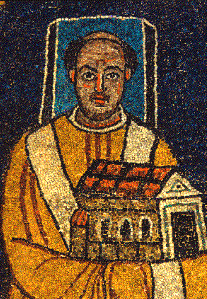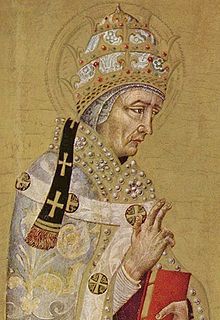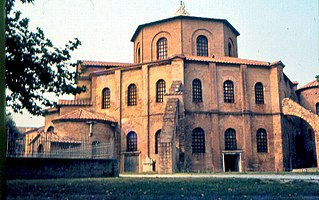Related Research Articles
Pope Gregory II was the bishop of Rome from 19 May 715 to his death. His defiance of Emperor Leo III the Isaurian as a result of the iconoclastic controversy in the Eastern Empire prepared the way for a long series of revolts, schisms and civil wars that eventually led to the establishment of the temporal power of the popes.
Pope Sergius I was the bishop of Rome from 15 December 687 to his death, and is revered as a saint by the Roman Catholic church. He was elected at a time when two rivals, Paschal and Theodore, were locked in dispute about which of them should become pope. His papacy was dominated by his response to the Quinisext Council, the canons of which he steadfastly refused to accept. Thereupon Emperor Justinian II ordered Sergius' arrest, but the Roman people and the Italian militia of the exarch of Ravenna refused to allow the exarch to bring Sergius to Constantinople.
Pope Sergius II was the bishop of Rome and ruler of the Papal States from January 844 to his death in 847. Sergius II's pontificate saw the Arab raid against Rome as well as the city's redevelopment.
Pope Valentine was the bishop of Rome and ruler of the Papal States for two months in 827. He was unusually close to his predecessor, Eugene II, rumoured to be his son or his lover, and became pope before being ordained as a priest. He was a nobleman and elected by nobility, which later became the custom.

Pope Paschal I was the bishop of Rome and ruler of the Papal States from 25 January 817 to his death in 824.
Pope Theodore I was the bishop of Rome from 24 November 642 to his death. His pontificate was dominated by the struggle with Monothelitism.
Pope Severinus was the bishop of Rome elected in October 638. He was caught up in a power struggle with Emperor Heraclius, who pressured him to accept Monothelitism. Severinus refused, which for over eighteen months hindered his efforts to obtain imperial recognition of his election. His pontificate was finally sanctioned on 28 May 640, but he died two months later.
Pope Constantine was the bishop of Rome from 25 March 708 to his death. One of the last popes of the Byzantine Papacy, the defining moment of Constantine's pontificate was his 710/711 visit to Constantinople where he compromised with Justinian II on the Trullan canons of the Quinisext Council. Constantine's was the last papal visit to Constantinople until 1967.
Pope John V was the Bishop of Rome from 23 July 685 to his death. He was the first pope of the Byzantine Papacy consecrated without prior imperial consent, and the first in a line of ten consecutive popes of Eastern origin. His papacy was marked by reconciliation between the city of Rome and the Empire.
Pope Conon was the bishop of Rome from 21 October 686 to his death. He had been put forward as a compromise candidate, there being a conflict between the two factions resident in Rome— the military and the clerical. He consecrated the Irish missionary St Kilian and commissioned him to preach in Franconia.
Adalbert was elected pope of the Catholic Church in February 1101 and served for 105 days. He was a candidate of the Roman party opposed to Pope Paschal II and is regarded today as an antipope. Prior to his election he was created a cardinal by the antipope Clement III. He was captured by partisans of Paschal II and forced to live out his days as a monk.
Sylvester IV, born Maginulf, was a claimant to the Papacy from 1105 to 1111 in opposition to Paschal II. A priest before his election, he was probably a native of Rome. He had the backing of the Roman militia and initially of the Holy Roman Emperor, Henry IV, who later forced him to abdicate. Today he is regarded as an antipope.
Theodore was a rival with Paschal for the papacy following the death of Pope Conon, and thus is considered an antipope of the Roman Catholic church.
John Platyn or Platinus was an Exarch of Ravenna.

Isaac the Armenian was an exarch of Ravenna hailing from the Kamsarakan clan. The chronology of the Exarchate in this period is uncertain: either he succeeded Euselnus and served c. 625 – 644; or he succeeded Eleutherius, and served 620 – 637.

The selection of the pope, the bishop of Rome and supreme pontiff of the Roman Catholic Church, prior to the promulgation of In nomine Domini in 1059 varied throughout history. Popes were often appointed by their predecessors or by political rulers. While some kind of election often characterized the procedure, an election that included meaningful participation of the laity was rare, especially as the popes' claims to temporal power solidified into the Papal States. The practice of papal appointment during this period would later result in the jus exclusivae, i.e., a right to veto the selection that Catholic monarchs exercised into the twentieth century.
Toto was the self-styled duke of Nepi, the leading magnate of Etruria, who staged a coup d'état in Rome in 767. He became Duke of Rome for a year until his death. The principal sources documenting his takeover are the vita of Pope Stephen III in the Liber Pontificalis and a surviving deposition of the primicerius Christopher from 769, preserved in a ninth-century manuscript of Verona, the Depositio Christophori.

The Byzantine Papacy was a period of Byzantine domination of the Roman papacy from 537 to 752, when popes required the approval of the Byzantine Emperor for episcopal consecration, and many popes were chosen from the apocrisiarii or the inhabitants of Byzantine-ruled Greece, Syria, or Sicily. Justinian I conquered the Italian peninsula in the Gothic War (535–554) and appointed the next three popes, a practice that would be continued by his successors and later be delegated to the Exarchate of Ravenna.

The Lateran Council of 649 was a synod held in the Basilica of St. John Lateran to condemn Monothelitism, a Christology espoused by many Eastern Christians. The Council did not achieve ecumenical status in either East or West, but represented the first attempt of a pope to convene an ecumenical council independent of the Roman emperor.

The Lateran Council of 769 was a synod held in the Basilica of St. John Lateran to rectify perceived abuses in the papal electoral process which had led to the elevation of the antipopes Constantine II and Philip. It also condemned the rulings of the Council of Hieria. It is perhaps the most important Roman council held during the 8th century.
References
- ↑ Raymond Davis (translator), The Book of Pontiffs (Liber Pontificalis), first edition (Liverpool: University Press, 1989), p. 83
- ↑ Ekonomou, Andrew J. Ekonomou, Byzantine Rome and the Greek Popes: Eastern influences on Rome and the papacy from Gregory the Great to Zacharias, A.D. 590–752 (New York: Lexington Books, 2007), p. 216